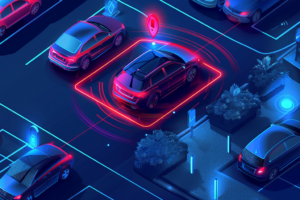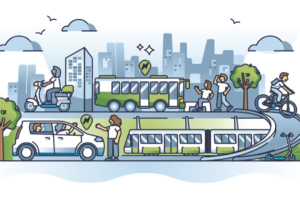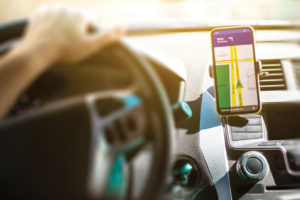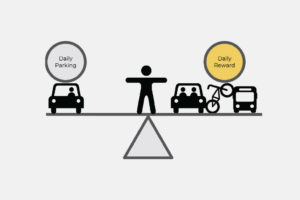By Giuseppina Alfarano
It is no secret that with time the world is changing right before us. Modes of transportation have evolved from once on foot, to horses and wagons, to engine-powered vehicles. Early vehicles started with basic automation and will soon progress to full automation driving.
Automated vehicles are no longer science fiction and have become the future and they can provide significant benefits in parking safety. Engineers will need to accommodate change through the new design and construction in relation to the Canadian parking industry.
Think of a time there was an amazing sale happening in the mall: this could have been Boxing Day or Black Friday. Imagine you are excited to get to the mall to save on these deals and you are faced with no parking spaces available. You’re circling around and around in the parking lot trying to find a parking space, but there is not one spot to be found. Once you find parking, you might have trouble parking, whether this is reversing, frontward parking or parallel parking. Then, before you can even get inside to see the great deals, you must find a parking machine to pay for parking. All these factors regarding parking are postponing you from getting to the sale.
Engineers can help make parking an easy, hassle-free experience allowing parkers to reach their destination quickly and efficiently. The implementation of autonomous vehicles allows this to become a reality. This lets users not to have to think twice on any aspect of parking.
Different kinds of engineers have separate roles in the design of autonomous vehicles to benefit the parking industry. Engineers assist in the creation of the automated parking system. This would require automation and robotics: implementing cameras, sensors, and robotics systems to locate…
By Adamo Donatucci
In the parking and mobility industry, technology is pivotal in shaping its future. Across the globe, certain nations are at the forefront, strategically embracing advancements such as autonomous vehicles, micromobility solutions, intermodal applications, and shared zero-emission initiatives.
Below is a comprehensive exploration of various country policies, exploring the complex process of technological adaptation and their concerted efforts toward achieving ambitious zero-emission goals.
1. Autonomous Vehicles — A prominent force at the forefront of the automotive industry.
Undoubtedly, autonomous vehicles (AVs) have become a focal point in the mobility industry in recent years. According to a recent study by the global management consulting firm McKinsey & Company, passenger car advanced driver-assistance systems and autonomous-driving (AD) systems could generate $300 to $400 billion in revenue by 2035. Level 4 high-driving automation is anticipated to contribute $170 to $230 billion, accounting for approximately 57% of the dominant vehicle type in sales. Overall, the expectation is that 12% of new passenger cars sold by 2035 will incorporate Level 3 and 4 autonomous technologies, with 37% featuring advanced AD technologies.
For years, global car manufacturers, particularly in the United States and Europe, have promised a future of self-driving vehicles. However, recent trends suggest China is poised to lead the global shared AVs market. Research indicates that the top 5 regions in China collectively command 51.3% of the total autonomous mobility market. At the same time, the United States holds 47.5%, and Europe (including the United Kingdom, France, Spain, and Germany) accounts for 62.3%.
Government support is a crucial factor in fostering AV adaptation. Since 2020, over $48 billion has been invested in AVs, with the US leading in investments in 2020 ($7.3 billion) and 2021 ($11.3 billion). China surpassed the US by investing $4.7…
Smart Cities are the way of the future. Every city in Canada is already planning its evolution into a Smart City and some are beginning to implement the initial elements.
The success of this evolution will depend largely on parking technology. Drivers—and eventually those in autonomous vehicles—need to park, and making it easier to park will dramatically reduce congestion on city streets. In the not-too-distant-future, when we leave the house, we’ll just enter our destination into our car’s GPS and then the car will guide us directly to the closest available parking space to that destination. If we haven’t already reserved and paid for a parking space in advance, we’ll be able to pay with our cell phones. If we need more time than we paid for, we’ll get a text reminding us when it’s time to move the car and asking if we want to pay for more parking—which we can do with our cell phones, without returning to the car.
The Foundation of Smart Cities
Intelligent parking technology will play the key role. Intelligent parking uses parking guidance sensors located in or over parking spaces to monitor whether they are occupied or available, and transmits that information to strategically located signs to guide vehicles directly to available spaces.
Parking guidance is already common in parkades throughout Canada. While it’s primarily used as a driver amenity designed to make it easier to quickly and conveniently find an available parking space, it also helps parking organizations better manage their assets by providing real-time data about how those assets are being utilized. Additionally, parking guidance also helps organizations increase their occupancy by eliminating the risk that drivers will give up looking for a space and…
By Ralph Bond
It seems that almost every week there is a news article about how the fast approaching world of autonomous vehicles (AV’s) will change the way we travel, impact on transportation related infrastructure – especially parking, and influence planning and design for urban real estate development. There is a wide divergence of opinion on when and how the impacts might occur and many unsubstantiated pronouncements. Nevertheless, an increasing number of developers as well as public sector agencies and municipalities are becoming concerned about the potential impacts and the risks associated with building new infrastructure that may not be suitable for the future.
The increased use of ride hailing services like Uber and Lyft is already reducing parking demand in varying degrees. For example, hotels in urban areas are reporting substantial reductions in parking demand because people are increasingly using ride-hailing services in place of rental cars. Some airports are also reporting significant declines in parking demand. More business people are using ride-hailing services in place of driving in some congested urban areas because it allows them to work while travelling and avoid the frustration of finding a parking space. Although these examples do not apply universally, it is an indication of how business related travel is changing when it comes to mobility in congested urban areas. We therefore prefer to think of the issue as the increased use of ride hailing services whether they are in autonomous vehicles or not.
Increasingly, both the public and private sector are asking questions such as:
- Do we really need this much parking?
- What is the risk that we will be stuck with a stranded parking asset?
- Can parking be designed for conversion to another use to mitigate the risk?
- Can increased use of shared public parking mitigate future risk?
- Will a lot more…
BY PAULO NUNES-UENO
Parking is out. Mobility is in.
Strolling the vendor booths at the Canadian Parking Association conference in Toronto this year makes that clear. We are all rebranding, it seems. Including me. The group I started at Seattle’s DOT, called the Transit and Mobility Division, manages transit, bikeshare, carshare, and of course, parking. Now as a consultant, I help clients retool their campus and city parking into ‘mobility’ services.
Mobility. Such a sweet word. If you close your eyes, you can almost hear…the future! Unfortunately, the transportation and ecological challenges we face won’t be solved through slogans. And the stakes couldn’t be higher. Get ‘mobility’ right and we stand a chance against climate change. Getting it wrong also spells extinction for those in the parking–I mean mobility–business.
Technology changes and growth make real adaptations all the more urgent. Re-urbanization is transforming cities throughout North America. Companies that a generation ago would have happily sprawled in suburban office parks are packing into downtown skyscrapers. Witness the new Amazon HQs headed to NYC and Washington DC. We can actually see this change happening inside our workplaces. The typical office from the early 2000’s housed 3 or 4 people per 1000 square feet. Today interior designers and architects with open offices and shared workstation have managed to more than double that.
Too bad transportation can’t claim anything close. None of the innovations to date increase the capacity of roadways or parking lots very much.
Driverless cars, the next big ‘innovation’ afoot, will actually make matters worse. Though we don’t know when autonomous vehicles are coming exactly, we can be sure they will impact the urban landscape. How? Because we have experience with services that drop people off at their destination and keep going. They’re called taxis….
By Milirsan Pugalendiran, B.Eng. Civil Engineering, Lassonde School of Engineering – York University
Tom Arnold Scholarship in Parking Industry Advancement at York University 2018 Recipient
With the rise of mass-manufactured automobiles, a new industry was created. The parking industry was born with rise of affordable automobiles and has changed significantly since Henry Ford’s invention of the assembly line in 19081. The parking industry started off with simple parking lot designs and has now evolved to parking lots capable of self-parking. We now face even greater challenges with the rise of Autonomous vehicles which calls for “Smarter” parking lots. This article looks at how the Parking Industry has changed over the years and what the future holds for parking.
Past
The first automobile can be as early found in the late 1600’s but the parking industry began with the rise of the mass-produced vehicle, the “Model T”1. Something that was only for the wealthy had now become affordable for the average person.
People needed a space to park their cars, which prompted the creation of parking lots. With 23 million cars in America, parking became a serious issue and city officials turned to engineers to invent a solution which resulted in the first parking lots4.
At the beginning, parking lots were designed with diagonal bays to accommodate the fairly large automobiles and to allow for ease of parking2. Early automobiles were also not as weather resistant compared to the automobiles of today3 and so had to be designed with weather protection in mind. High-rise, fully enclosed parking garages were built to accommodate the larger volumes and to protect these vehicles from the elements. Innovations such as the “D’Humy ramp system”, which created split-level floors to maximize spaces, were incorporated into the high-rise buildings3.
Vehicles were parked by professional valets…
By Jessica Bates
A decade from now, many of us could be commuting to work in cars that drive themselves. For some, this sounds like science fiction; others can’t imagine willingly handing over the wheel to a computer. Nonetheless, driverless cars are almost certainly coming to a road near you, and they are likely to transform how we work and live in more ways than we can predict.
Driverless cars—also called autonomous cars or self-driving cars—are unmanned vehicles capable of sensing their environments and navigating without any human input. Early versions of these cars already exist and they are becoming more reliable and sophisticated every day. Commercial building owners and managers need to start thinking about how the autonomous vehicle revolution will affect their properties—from the loss of parking revenue to new development opportunities to the potential increase in tenant amenities.
THE TIPPING POINT
Cities already are starting to see significant shifts in commuter behavior with the rise of ride-sharing services, such as Uber and Lyft. More and more young people are entering the workforce without owning a car—or even having a driver’s license. J.F. Finn, III, AIA, principal and studio director for architecture and design firm Gensler, believes these behaviors will accelerate the rise in self-driving vehicles. “My nephews and nieces have no interest in car ownership—it doesn’t represent freedom and autonomy the way it has to previous generations,” Finn explains. “Many people are getting around just fine these days without the costs and inconveniences of owning their own car.”
Gensler’s research team predicts that, by 2021, ride-sharing services will become the dominant form of transportation, at least in urban centers. He calls this the “tipping point” where large numbers of autonomous vehicles become realistic. While today’s autonomous cars still require some human oversight, there is widespread optimism that fully autonomous cars will…










